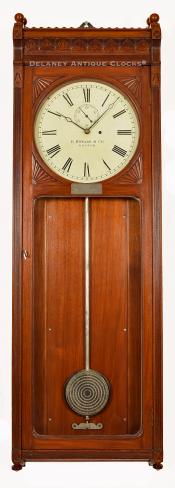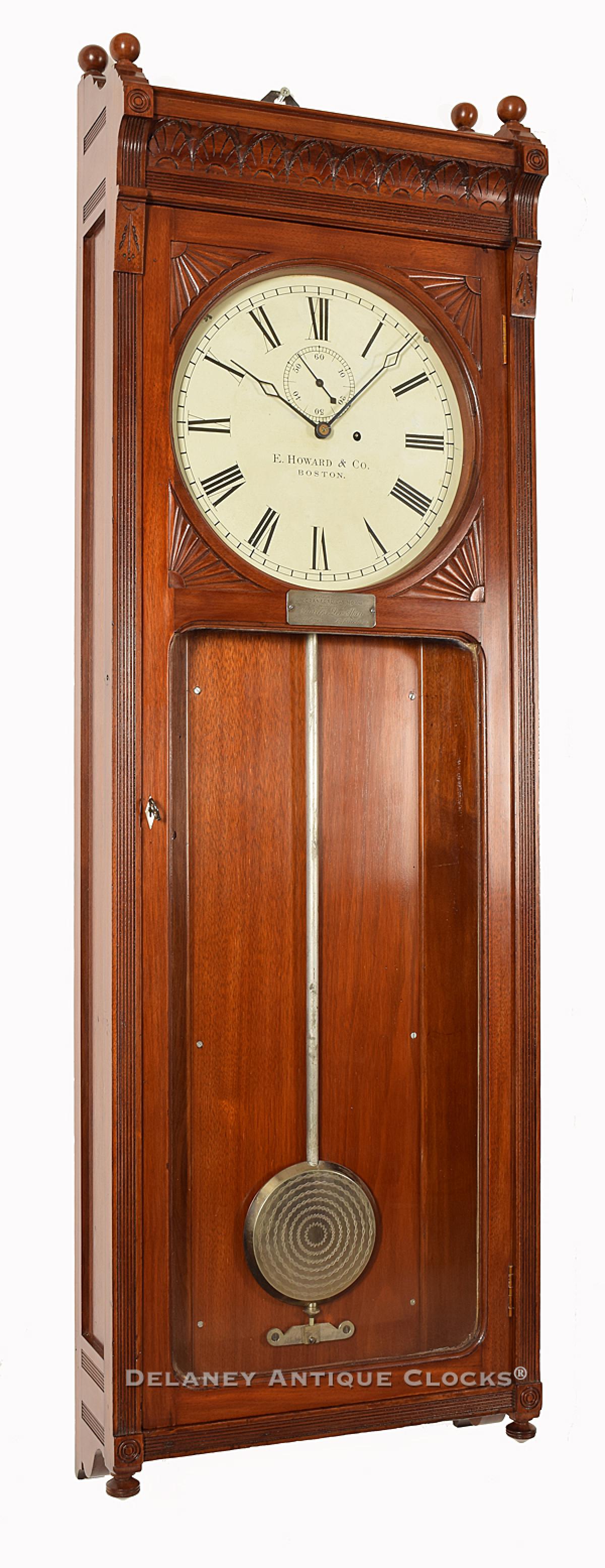E. Howard Clock Company Model No. 72-14 Regulator. The Cranford New Jersey Casino Regulator. 221034.
Applied to the front door just below the dial aperture is a presentation plaque that reads: "Presented to the/ CRANFORD CASINO / in remembrance of / Charles Leo Abry, / March 10th, 1898 - by his Wife."
The town of Cranford was once known as the "Venice of New Jersey." The town began to blossom in 1861 with the completion of a railway bridge across Newark Bay. The bridge connected the Central Railroad of New Jersey to New York City. By 1871, the adult population was in excess of 600, and the town was incorporated on March 14. The Cranford Casino was originally built in 1892 and rebuilt in 1896 after it suffered damage in a fire. This structure was built on a bend on the Rahway River. It was a "country club" for the growing recreational community in the town. The growing interest in activities related to the Rahway river made this an ideal location. The clubhouse was described in 1900 as having exceptional facilities and interior decoration, such that "it would be hard to even find its equal." The rebuilt clubhouse incorporated "the most modern ideas of a clubhouse," having bowling alleys, reading rooms, a billiard and pool room, a reception hall, a smoking room, a supper room, a ballroom, and a club hall.
Charles Abry was a first lieutenant in the Civil War. He went on to be a New York Banker and was the Commodore of the Cranford River Improvement Association. Charles Abry was one of Cranford, NJ's most prominent residents. He died in 1895.
The Model No. 72 came in two cataloged sizes. These were based on the sizes of the dial, which included both a 12 and a 14-inch diameter dial. This is the larger 14-inch version. The weight-driven movement is die-stamped by the Maker on the front plate, E. Howard & Co., / Boston. It is designed with a Graham Dead Beat Escapement, maintaining power, double suspension spring mounting, and a Geneva Stop winding mechanism. The brass movement is designed to run eight days on a full wind and is powered by the original cast iron weight, which is cast with the numeral 1. This runs behind a guideboard incorporated into the design of the case. It is not visible. The pendulum rod is made of seasoned cherry and retains its original silver paint. The heavy bob is nickel plated and features a fancy damascened design or pattern on the front surface. The enameled zinc dial measures approximately 14 inches in diameter and is original to this clock. It features the Maker's name, working location, and a true seconds register.
The black walnut case is nicely decorated with various carvings and has been recently refinished. The construction of this case is designed to compensate for expansion and contraction due to changes in humidity and temperature. As a result, when these large regulator clocks are set up correctly, they vary only seconds a month. This example measures 5 feet 5 inches long.
The existing E. Howard Company records are not complete. They do give one a good idea of the production numbers for a particular time period. These list 152 Model 72 clocks as being made. Fifty-six of these were ordered with 14-inch diameter dials. Only twelve were ordered with Black Walnut cases.
Inventory number 221034.
The E. Howard & Company succeeded the Howard & Davis firm in 1857. The Howard & Davis firm was comprised of Edward Howard and David Porter Davis and was established in 1842 in Roxbury, Massachusetts. Both men had just completed their clock apprenticeship under the guidance of Aaron Willard Jr in Boston. The Howard & Davis firm made high-grade clocks, precision balances, sewing machines, fire engines, and watches. After the dissolution of Howard & Davis, Edward Howard became Boston's leading manufacturer of weight-driven residential and commercial clocks. The firm also made a large number of tower clocks and watchman and salve clock systems. These sold well in the last quarter of the 1800s.
It has been said that the E. Howard Clock company never made an inexpensive clock, and everything they made was of very good quality. As a result, Howard clocks have become very collectible and are prized by their owners. Today, the E. Howard name enjoys outstanding name recognition.
For a more in-depth reading of Edward Howard and his various businesses, please read "Willard's Patent Time Pieces," written by Paul Foley.
















